Using digital twins offers numerous benefits, such as improving quality, a better understanding of costs, faster project completion, and revenue growth opportunities but can digital twins help us decarbonise the built environment? If the answer is yes, how can we make it happen?
Twenty years ago, the built environment sector was inundated with stories and pitches about building information modelling (BIM). Fast forward to today, and the industry is now fully focused on information management with a clear course correction taking shape. Simultaneously now, digital twins have become the new buzzword. There is no shortage of news, information, and reports about their use and applications in our industry. Using digital twins is said to offer numerous benefits, such as improving overall quality, a better understanding of costs, a digital record of parts and components, faster project completion, and revenue growth opportunities for all stakeholders. However, as the story of digital twins unfolds, we now ask ourselves: can digital twins help us decarbonise the built environment? If the answer is yes, how can we make it happen?
1. The power of digital twins: Revolutionising industry and beyond
The term “digital twin” refers to a virtual replica of a project or asset that works in harmony with its physical counterpart. Digital twins have many formal definitions. For example, Digital Twin Consortium defines it as ‘A digital twin is a virtual representation of real-world entities and processes, synchronised at a specified frequency and fidelity.’ A virtual replica can include any digital representation, including CAD models, federated BIM models, images, videos, point clouds, documents, or spreadsheets. A physical asset can be a city, a district, an infrastructure, such as a bridge or highway, a building, a hospital room, or an office building, down to its components, such as a pump, an excavator, a tower crane, a worker, or an occupant. Additional definitions and details are available in the 2022 RICS WBEF report entitled “Digital twins from design to handover of constructed assets.”.”
Within its definition, there are two important considerations we would like to highlight. The first consideration is that a digital twin contains not only data and information about the physical asset but also the processes (for example, safety monitoring on a construction site, handover of an asset, pump maintenance schedules, or monitoring of workstations) that are required for the asset’s design, delivery, and management. The second consideration is how the virtual replica is connected and synchronised with real-world entities and processes. In comparison with a static digital representation, a digital twin is characterised by bidirectional synchronisation at a regular interval (frequency) and with sufficient fidelity (detail).
2. Why industry leaders can’t afford to ignore digital twins
So, why should industry leaders be interested in digital twins? Digital twins create a connected virtual version of an asset or process to generate the operating outputs and ensure the right information is available to the right people at the right time, enabling them to make the best decisions efficiently and sometimes autonomously. Therefore, digital twins have the potential to make the design, construction, handover, operation, maintenance, renewal, and end-of-life process highly efficient thanks to the integrated and connected use of data and information. So, for an industry leader, digital twins offer a connected view of the workflows, processes, and practices within their organisations and, therefore, must be part of their digital transformation program.
3. Climate change cannot be addressed without decarbonising the built environment sector
The built environment is responsible for 79% of total emissions by some estimates(1), out of which emissions directly controlled by the sector are estimated at 43% of the global emissions(2). To understand what these statistics mean, it is crucial to contextualise them to determine what interventions are required and how digital twins may be able to assist. Let us first look at the whole-life carbon emissions as explained by the equation provided below and illustrated in figure 1(3).
Whole-life carbon emissions = Embodied Carbon + Operational Carbon + Beyond the Lifecycle Carbon
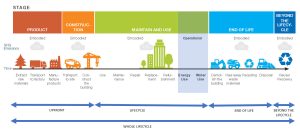
Figure 1 Edited version of BS EN 15978-2011(4)
Where: An asset’s embodied carbon emissions include the net greenhouse gas (GHG) emissions from construction materials (extraction, transport, and manufacture) and construction processes throughout its life cycle. An asset’s upfront embodied carbon is associated with construction, its life cycle embodied carbon is associated with use, maintenance, repair, replacement, and refurbishment, and its end-of-life embodied carbon is associated with demolition, transport, and waste removal.
An asset’s operational carbon is the GHG emissions it produces over its lifetime from energy and water use.
Beyond the life cycle carbon emissions are emissions beyond the system boundary from reuse, recycling, energy recovery and other recovery, covering aspects of circularity.
GHG emissions from using the asset during the use stage can also occur. These emissions are called user carbon and are not directly within the control of the built environment sector, so they are reported separately.
Over the last several decades, the focus has been on reducing operational carbon, primarily through reducing energy and water consumption. And now, as operational carbon reduces, the importance of embodied carbon increases. However, this is not a zero-sum game, as an asset or portfolio’s embodied and operational carbon emissions are interconnected. For example, when choosing a building envelope, the designer should select one with a low embodied and operational carbon footprint. A whole-of-life and whole-of-asset approach is needed in the selection process, as well as efficient data and information sharing between project team members, and this can be achieved through digital twins.
4. Urgent need for climate action through better infrastructure design and digital twins
On March 20, 2023, the IPCC released its 6th report(5), which warned that current climate action is insufficient. The report emphasised the importance of cities, settlements, and infrastructure in achieving deep emissions reductions and advancing climate resiliency. The report called for improvements in the design and planning of settlements and infrastructure, more efficient use of assets, optimised material consumption, demand-side emissions reductions, inclusive long-term planning, and the use of green and blue infrastructure for carbon uptake and storage. These measures require changes in regulations and policies, low-carbon materials, national databases and benchmarks, and training and capacity building. By providing efficient information management processes and enabling connected decision-making tools, a digital twin can be used to meet these needs and provide a way to implement the action plan outlined in the IPCC report.
5. How can digital twins decarbonise the built environment assets?
In the industry’s current state, most digital twin use cases revolve around the operation phase of an asset. RICS conducted a survey in November 2021 that found that digital twins can be used during all construction and operation phases. Creating a digital twin at any stage of the project life cycle is possible, and if the aim is to maximise its benefits, a clear business case and value proposition should be outlined, and planning should occur early in the process (see Figure 2). To illustrate the use of digital twins in both phases, we present two use cases with a strong sustainability focus.
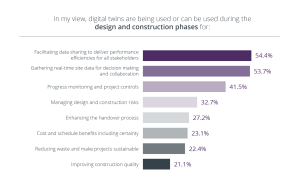
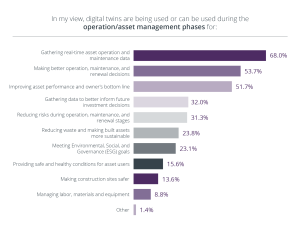
Figure 2: Uses of digital twins during design and construction and the operation of the asset(6)
5.1 Use case – Material selection and substitution
With the help of digital twins, project teams can make informed decisions about materials, building components, and systems. A digital twin can help identify the best options based on factors such as cost, environmental impact, and performance based on physics-based simulations. A building’s carbon emissions require a detailed understanding of its design and materials, along with accurate and comprehensive supply chain and manufacturing data, which is often a complicated and cumbersome process.
Consider replacing existing building windows, for example. A digital twin can generate different window replacement scenarios by leveraging data collected from the physical asset. This enables project teams to compare and evaluate different options, including insights into each option’s life cycle carbon emissions and costs (see Figure 3). When installing windows in a new building, a similar assessment can be used to determine which will emit the least amount of carbon dioxide.
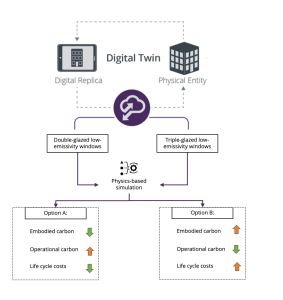
Figure 3: Physics-based simulation of digital twins
5.2 Use Case: Energy efficiency and sustainability through closed-loop analysis and continuous monitoring
Using closed-loop analysis (see Figure 4), building systems and equipment can be monitored, analysed, and continuously improved in real-time. Various sensors and data sources are used to collect data to identify patterns and potential areas for improvement. We can improve performance and reduce energy consumption by analysing building systems and equipment, and monitoring ensures that adjustments are effective and identifies opportunities for further improvement.
By integrating this approach into broader contexts, significant energy, carbon, capital, and operational savings can be uncovered. This approach allows building operators to consider environmental factors, resource usage, and the impact of social, economic, and transportation factors. Operators can reduce costs and environmental impact by optimising building performance and increasing efficiency.
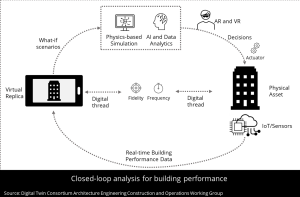
Figure 4: Digital twin-based analysis of asset performance(7)
Challenges and limitations of digital twins
RICS (Figure 5) notes that digital twins have the potential to reduce carbon emissions in the built environment, but their implementation is hindered by several factors, such as:
- Investing in digital twins is costly, which is why some organisations may not adopt them
- Clients may not be aware of the benefits of digital twins or may not be willing to invest
- A lack of trained and skilled workforce may make some organisations hesitant to adopt digital twins due to their perceived complexity
The key to overcoming these blockers is to raise awareness of the benefits of digital twins, especially concerning their role in reducing carbon emissions in the built environment. Using them has tangible benefits that can only be demonstrated through case studies and knowledge sharing.
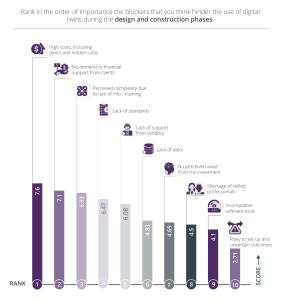
Figure 5: Blockers to the use of digital twins
It can be challenging to calculate the carbon emissions especially embodied carbon emissions of built assets, for several reasons:
- A lack of standardised methods makes it difficult to compare results across different studies and projects when calculating embodied carbon emissions for buildings.
- A long supply chain can make tracking and accounting for emissions associated with building materials from various sources challenging.
- The availability of data on the carbon emissions associated with building materials can be challenging, particularly for materials not commonly used or produced in all regions.
- Timeframe considerations: The timeframe over which embodied carbon emissions are assessed can significantly impact results. Timber, for example, has a relatively low carbon footprint in the short term, but its long-term carbon sequestration potential makes it more favourable.
As per the call for action in the IPCC’s recent report, the built environment sector must prioritise carbon emissions reductions and climate resiliency through improved design, optimised material consumption, and the use of green and blue infrastructure. Digital twins can help address this challenge. A digital twin utilises data to improve the information management processes used to design, construct, operate, and decommission built assets. This, in turn, helps these assets deliver economic, environmental, and social outcomes. Through a whole-life and whole-asset approach, digital twins can help decarbonise the built environment sector. The implementation of digital twins can be an essential tool in achieving these goals, alongside which national databases and benchmarks, as well as training and capacity building, should be encouraged and supported.
References:
(1) Thacker S, Adshead D, Fantini C, Palmer R, Ghosal R, Adeoti T, Morgan G, Stratton-Short S. 2021. Infrastructure for climate action. UNOPS, Copenhagen, Denmark.
(2) United Nations Environment Programme (2022). 2022 Global Status Report for Buildings and Construction: Towards a Zero‑emission, Efficient and Resilient Buildings and Construction Sector. Nairobi.
(3) World Green Building Council. (2019). Bringing Embodied Carbon Upfront: Coordinated Action for the Building and Construction Sector to Tackle Embodied Carbon. https://worldgbc.org/article/bringing-embodied-carbon-upfront/
(4) World Green Building Council. (2019). Bringing Embodied Carbon Upfront: Coordinated Action for the Building and Construction Sector to Tackle Embodied Carbon. https://worldgbc.org/article/bringing-embodied-carbon-upfront/
(5) IPCC Synthesis Report for the Sixth Assessment Report – Summary for Policymakers, March 2023 https://report.ipcc.ch/ar6syr/pdf/IPCC_AR6_SYR_SPM.pdf
(6) 2022 RICS WBEF report entitled “Digital twins from design to handover of constructed assets, https://www.rics.org/content/dam/ricsglobal/documents/research/digital-twins-from-design-to-handover-of-constructed-assets.pdf
(7) Decarbonizing the Built World: A Call to Action, Digital Twin Consortium, March 2023, https://www.digitaltwinconsortium.org/decarbonizing-the-built-world-a-call-to-action-download-form/
Anil Sawhney, Ph.D. PMP FHEA FRICS
Head of Knowledge and Practice, Construction and Infrastructure Sector
RICS
Cristina Savian
CEO and Founder
BE-WISE
















